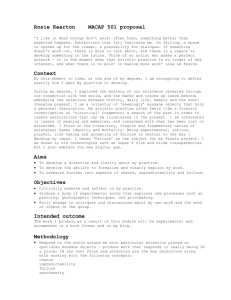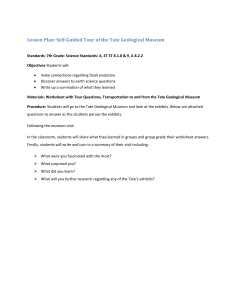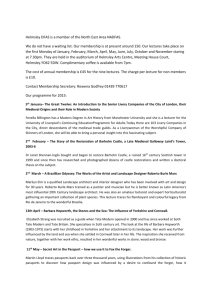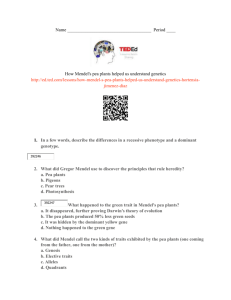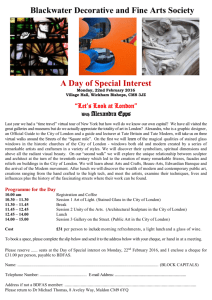SPENCER-KOCH Tate - Ruling - Courts Administration Authority
advertisement
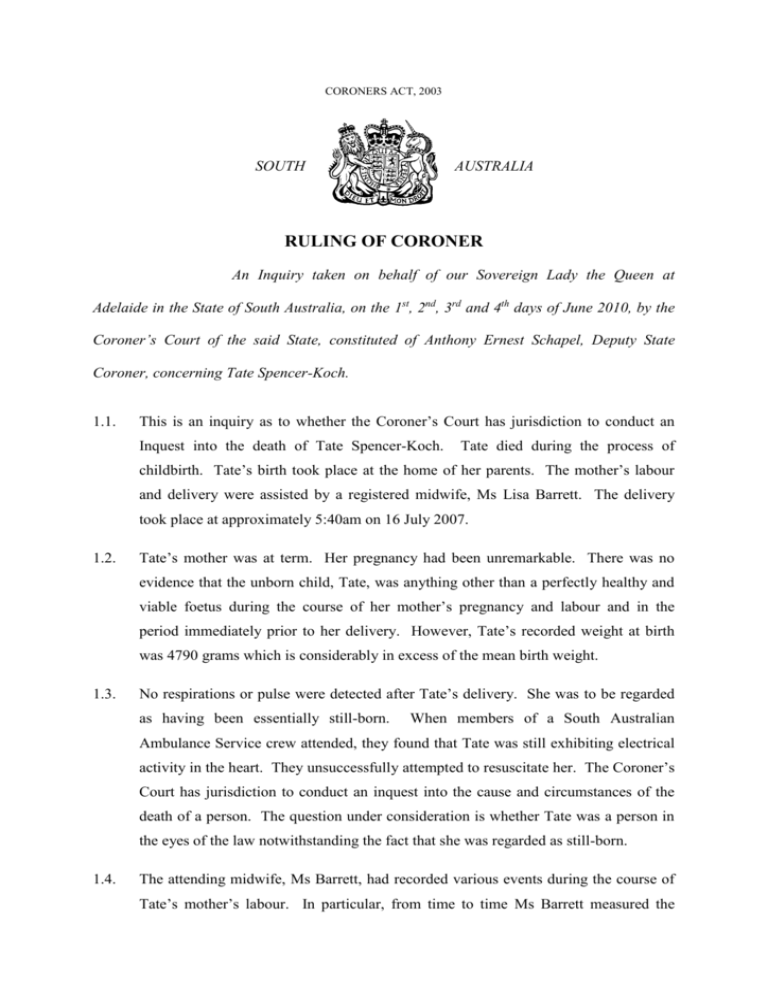
CORONERS ACT, 2003 SOUTH AUSTRALIA RULING OF CORONER An Inquiry taken on behalf of our Sovereign Lady the Queen at Adelaide in the State of South Australia, on the 1st, 2nd, 3rd and 4th days of June 2010, by the Coroner’s Court of the said State, constituted of Anthony Ernest Schapel, Deputy State Coroner, concerning Tate Spencer-Koch. 1.1. This is an inquiry as to whether the Coroner’s Court has jurisdiction to conduct an Inquest into the death of Tate Spencer-Koch. Tate died during the process of childbirth. Tate’s birth took place at the home of her parents. The mother’s labour and delivery were assisted by a registered midwife, Ms Lisa Barrett. The delivery took place at approximately 5:40am on 16 July 2007. 1.2. Tate’s mother was at term. Her pregnancy had been unremarkable. There was no evidence that the unborn child, Tate, was anything other than a perfectly healthy and viable foetus during the course of her mother’s pregnancy and labour and in the period immediately prior to her delivery. However, Tate’s recorded weight at birth was 4790 grams which is considerably in excess of the mean birth weight. 1.3. No respirations or pulse were detected after Tate’s delivery. She was to be regarded as having been essentially still-born. When members of a South Australian Ambulance Service crew attended, they found that Tate was still exhibiting electrical activity in the heart. They unsuccessfully attempted to resuscitate her. The Coroner’s Court has jurisdiction to conduct an inquest into the cause and circumstances of the death of a person. The question under consideration is whether Tate was a person in the eyes of the law notwithstanding the fact that she was regarded as still-born. 1.4. The attending midwife, Ms Barrett, had recorded various events during the course of Tate’s mother’s labour. In particular, from time to time Ms Barrett measured the 2 unborn child’s heart rate with the use of a doppler machine. This machine will not determine the state of wellbeing of the unborn child with the same precision as other equipment that is utilised in a hospital labour ward such as a cardiotocograph, but it is capable of facilitating the recording of the foetal heart rate with reasonable accuracy. At all material times Tate’s foetal heart rate was within the limits of normality. At 5:10am the head of the child crowned and Ms Barrett told me in evidence that at that point the heart rate was 120 beats per minute which is at the lower end of the scale of normality. There had been earlier higher foetal heart rates recorded. The heart rate of 120 beats per minute at 5:10am was the last measured heart rate prior to the eventual delivery of the child some 30 minutes later. The heart rate was regarded as satisfactory at 5:10am. 1.5. At 5:20am the child’s head was delivered and at that point she became entrapped within the birth canal due to shoulder dystocia. Although the head of the child was delivered at that point, and was ultimately exposed to the atmosphere after removal of her mother from the homebirth bath, the child in this position would not necessarily be expected to breathe and the compression of its chest would make it very difficult if not impossible to do so in any event. At that stage Tate continued to be reliant upon her mother for the delivery of life sustaining oxygen by way of the still attached umbilical cord. In the event, I was told in evidence that the child remained in this position relative to her mother until her eventual delivery some 20 minutes later. The particular set of circumstances that prevailed over that period of time is known to be life threatening to the undelivered child and the evidence is that this was the case here, causing as it did significant hypoxia (deprivation of oxygen). Ms Barrett, the midwife, conducted a number of manoeuvres that do not need to be described in detail, but full delivery the child was only achieved after that period of 20 minutes. 1.6. The relevant provisions of the Coroners Act 2003 stipulate that the jurisdiction to conduct an Inquest in the Coroners Court is enlivened when there has been the reportable death of a person. A coronial Inquest in this State consists of an inquiry into the cause and circumstances of a reportable death of a person1. Whether a living human entity is a ‘person’ so as to bestow jurisdiction on the Coroner’s Court is a matter of law and fact. To this question I apply the civil standard of proof, namely the balance of probabilities. 1 With regard to the jurisdictional requirements for the See Sections, 3, 13 and 21 of the Coroners Act 2003 3 Coroners Court of South Australia, I apply the common law definition of what constitutes a person in the eyes of the law. The relevant rule of law has been referred to as the ‘born alive’ rule. As indicated in the decision of the Court of Criminal Appeal in New South Wales in R v Iby (2005) 63 NSWLR 278, the rule consists of two distinct components. First, to be regarded as a person the foetus must be shown to have completely left its mother’s body and secondly, the child must be shown to have been alive at, or after, birth2. It will be seen from those two requirements that a child who dies in the womb prior to its complete removal from the mother and who therefore exhibits no sign of life following that full delivery will not be regarded as having existed as a person in the eyes of the law, notwithstanding that the evidence clearly establishes that at some point in time, even very close to the child’s delivery, it had existed as a healthy and viable foetus. I would only add that for some time now academic writers and jurists have regarded the born alive rule as anachronistic and have pointed to the fact that physiologically there is little to distinguish the unborn foetus as it exists immediately prior to its delivery on the one hand from the healthy child immediately following delivery on the other. It is a matter for the legislature as to whether or not these technical and some might say immaterial niceties, based as they are upon the need to demonstrate life only after the child has been ‘fully extruded from the mother’s body’3, should continue to be entertained in the context of the investigation of peri-natal death. 1.7. This Court has had occasion to consider issues such as those raised in this case in the past. In the matter of the death of Matthew McPhail-Osborne, an inquiry that was conducted in 20024, I found that the evidence was insufficient to establish anything other than that the deceased had died in utero prior to his delivery. The evidence in that matter had been insufficient to establish that the child had taken a breath at any time after he was fully delivered, that he had exhibited a heart beat or pulse or had exhibited any other sign of life. There was in that case no evidence before me as to whether or not at any time after delivery there had been any residual electrical activity in the heart. By any definition of what might constitute death or life for the purposes of the jurisdiction of the Coroners Court, there was no evidence that Matthew McPhail-Osborne was, in the eyes of the law, a person and that therefore there was no evidence that there had been the death of a person. In the case of Matthew McPhail- 2 Per 3 4 the judgment of Spigelman CJ at para 27 with whom Grove & Bell JJ agreed R v Hutty [1953] VLR 338 at 339 per Barry J Inquest 20/2002 4 Osborne I was persuaded that the Death (Definition) Act 1983, while not in any way altering the common law requirement that for a human entity to be regarded as a person it must be fully delivered from its mother, modified the common law to the extent that after delivery there must be evidence of some function of the brain and/or circulation of blood within the body and that a person is not to be regarded as having died unless there had been irreversible cessation of one of those elements of life. This in effect rendered the test as to whether life had existed after delivery more stringent than the test at common law. In the event, I ruled that I had no jurisdiction to hear an inquest into the cause and circumstances of Matthew McPhail-Osborne’s death. As will be seen, in the light of what fell from the New South Wales Court of Criminal Appeal in R v Iby, that aspect of my decision in McPhail-Osborne based upon the perceived application of the Death (Definition) Act 1983 may need to be revisited. In any event the decision in the case of McPhail-Osborne to the effect that the Court had no jurisdiction would remain unaltered. In particular, even having regard to the less stringent common law requirement as to what might constitute a sign of life, there were no such signs in Matthew McPhail-Osborne after his delivery. Thus the decision that the Court had no jurisdiction to conduct an Inquest into that matter would remain unaffected by anything I decide in the present case. The decision in the McPhailOsborne would remain the same today, regardless of the outcome here. I add that it would be erroneous to suggest that in the current proceedings the Court has in any way entertained the notion that the common law born alive rule has been abrogated or that the Court has in any way considered assuming jurisdiction over still-births generally, over terminations of pregnancies or over miscarriages. In my view it is unhelpful to pose the question under discussion in this case in terms of whether Tate was still-born or not. One does not find the expression still-born anywhere in the jurisdictional provisions of the Coroners Act. The only issue that requires fresh consideration in the current case is the question of what may constitute life for the purposes of the born alive rule, in other words, what may satisfy the second distinct component of the rule as identified in 2005 by Chief Justice Spigelman in R v Iby. 1.8. For these purposes I do not need to recite the history of the common law born alive rule except to state that the rule has existed for ages and, as observed by the Court of Criminal Appeal of New South Wales in R v Iby, was developed at a time when there 5 was relatively primitive medical knowledge and technology and there was a high rate of infant mortality5. 1.9. The judgment of the Court of Criminal Appeal of New South Wales in R v Iby identifies the following features of the born alive rule: 1) The born alive rule has never encompassed a requirement of viability in the sense of the physiological ability of a newly born child to survive as a functioning being6. To my mind this is hardly surprising because the question of whether a newly born infant has been born alive is invariably examined in circumstances where there is a very real issue as to its viability and physiological ability to survive and usually arises in cases where the child eventually dies. 2) The rule is satisfied by any indicia or sign of independent life; 3) There is no requirement that unassisted breathing must exist before a baby can be said to be born alive; 4) Evidence of a child’s heart beating after delivery is sufficient evidence that a child was born alive; I would add here that this aspect of the judgment also identifies that a heart beat alone is sufficient to satisfy the common law born alive rule, even in the absence of any other sign of life7. 5) That the New South Wales identical equivalent of the South Australian Death (Definition) Act 1983 as contained in Section 33 of the Human Tissues Act 1983 (NSW) does not change the definition of life for the purposes of the common law born alive rule, nor should the born alive rule be adapted so as to be consistent with the statutory definition of death. 1.10. In my opinion this Court should follow and apply all aspects of the decision of the New South Wales Court of Criminal Appeal in R v Iby. That said, I acknowledge two things. Firstly, the judgment of the NSW Court was delivered in the context of a criminal prosecution in another geographical jurisdiction. The decision therefore is not binding on the Coroners Court of South Australia. Secondly, there is an available 5 6 7 Paragraph 63 Paragraph 54 Paragraph 62 6 argument that the NSW statutory definition of death can be distinguished contextually from the South Australian equivalent. I deal with that question now. 1.11. The New South Wales Court of Criminal Appeal for two reasons rejected the submission that the New South Wales’ equivalent of the South Australian Death (Definition) Act 1983 was relevant to the interpretation of the born alive rule. Firstly, the New South Wales’ equivalent definition of death, as contained in Section 33 of the Human Tissues Act 1983 (NSW), although said to apply ‘for the purposes of the law in New South Wales’, is contained within a specific legislative framework that was designed to facilitate a national scheme intended to uniformly identify the point in time when death occurs with matters such as the harvesting and donation of human organs in mind. In other words, the NSW legislation, and by extension its equivalent in other Australian States, was never intended to have universal application, and in particular, application to the criminal law or to the jurisdictional requirements of a court. Secondly, Spigelman CJ expressed the view that the courts should refrain from introducing a meretricious symmetry between the common law and statute law and that the statutory definition of death does not, other than in the context of semantic symmetry, require a corresponding definition of life, particularly so for the purposes of a common law rule which in His Honour’s view was anachronistic and which adopted an artificial and non-scientific concept of when life begins. His Honour held that other than in semantic terms, the test for the born alive rule is not the reciprocal of death as defined by statute. 1.12. As to the first of those objections, the South Australian Death (Definition) Act 1983 is distinguishable from the New South Wales equivalent insofar as the former contains a stand alone definition of death not legislatively contained within, nor even by necessary implication confined to, any particular context such as organ donation. The definition of death as contained within the South Australian legislation is said to exist ‘for the purposes of the law of this State’. It might be said that there is therefore no warrant to confine its operation to unspecified and unidentified purposes such as organ donation. Arguably, it has general application and that it does indeed define death for the purposes of the jurisdictional provisions of the South Australian Coroners Act 2003. I so held in McPhail-Osborne. In this regard, one has to acknowledge that regardless of what the NSW Court of Appeal has decided, there is an obvious attraction in applying a statute that on the face of it defines death generally 7 for the purposes of the whole of the law of a State, and moreover does so in a totally unspecified context, to another statute that has the subject of death as its core ingredient such as the Coroners Act 2003. One might also observe that when the South Australian legislature enacted the existing Coroners Act in 2003, it elected not to legislatively eschew the already existing statutory definition of death. However, the second broad objection to the applicability of the definition of death that the New South Wales Court of Criminal Appeal identified, based on the need to avoid ‘meretricious symmetry’ in the law, also needs to be considered. It is an objection that is equally applicable when considering the relevance of the South Australian legislation. There are in my view difficulties associated with this argument as well given that in both a criminal context and in this Court’s jurisdictional context, one is not so much concerned with the question of when life begins as with the causation of death. However, I am persuaded that in conformity with the decision of the NSW Court of Appeal I should hold that the existence of a statutory definition of death in and of itself does not also provide a definition of what might constitute life for the purposes of the law. Accordingly, contrary to what I held in the McPhail-Osborne Inquest, I hold that the South Australian Death (Definition) Act 1983 does not in any sense alter the requirements of the common law born alive rule. This means that there is no jurisdictional requirement that there was some function of the brain or circulation of blood within Tate before I can regard the Court as being vested with jurisdiction to investigate her death. 1.13. I re-emphasise that this is in fact the only aspect of the McPhail-Osborne ruling that requires revisiting. In all other senses, the McPhail-Osborne decision would remain the same, namely that the Court there had no jurisdiction to entertain a coronial Inquest. 1.14. I add here that, as already alluded to, since the McPhail-Osborne ruling the South Australian legislature enacted a new Coroners Act that replaced the statute under which McPhail-Osborne came to be considered. However, as far as the jurisdiction of the Coroners Court as it now exists is concerned, there is no material difference between the two pieces of legislation. 1.15. Accordingly, whether there is jurisdiction in this particular matter, and whether the child Tate was born alive, is to be wholly decided by reference to the existing 8 common law and for these purposes I take that from the decision of the New South Wales Court of Criminal Appeal in R v Iby. 1.16. Before examining the evidence in the instant case, it is worthwhile examining the factual circumstances upon which the decision in R v Iby was based. The appellant in R v Iby had been convicted of the offence of manslaughter. The victim of his offence was a newly born child who was born and then died in the aftermath of a motor vehicle accident. The appellant had been driving a vehicle at an excessive speed and in an erratic manner. His vehicle collided head on with a car driven by a woman who was 38 weeks pregnant. Following the woman’s admission to hospital, an emergency caesarean was performed and the infant was delivered in a poor condition. The infant was pronounced dead exactly two hours after his birth. In those two hours the child was supported by mechanical respiration. It was said that in that state he was not breathing independently. There was also a heart beat in existence naturally enough, but it is fair to infer that this heart beat, although spontaneous, was also, albeit indirectly, being supported by the artificial ventilation. The heart rate fluctuated and at one time became undetectable but it was restored and the child’s blood pressure, although low, indicated that there was circulation of the blood taking place. The baby never breathed other than by way of mechanical assistance. At approximately one hour after birth an electroencephalogram (EEG) was used to measure the electrical activity in the baby’s brain. A flat trace was indicated. Indeed, there was no evidence that at any time following full delivery there was brain activity, although it might be assumed that there was enough to enable an oxygenated heart to beat. The child died two hours following delivery. I am not certain whether death occurred in spite of the artificial ventilation or whether the artificial ventilation was removed following the diagnosis of brain death. Despite the fact that the child’s brain function was virtually non-existent, and that its life was being sustained by artificial means, the Court held that it had been born alive for the purposes of the common law rule. Indeed, it was held that the heart beat was, in and of itself, sufficient to be regarded as a sign of life. I take this to mean that it would have been so regarded even in the absence of any ventilation, be it spontaneous or artificial. It is also clear that any sign of life that existed in the child in the R v Iby case was non life sustaining and temporary. The Court also regarded it as relevant that but for the trauma occasioned by virtue of the motor vehicle accident, there was no reason to suppose that the child would not have been born as a healthy and living person. The Court 9 observed that the viability of a foetus can now be established in a manner that was beyond the realms of contemplation when the born alive rule was adopted. Having regard to the contemporary ability to establish the viability of a foetus to a point almost before delivery, the Court was of the view that the born alive rule should now be applied consistently with contemporary conditions by affirming that ‘any sign of life after delivery is sufficient’8. 1.17. As to the facts of the case before me, there is no evidence that Tate Spencer-Koch was anything other than a viable and healthy foetus right up to the point of the crowning of her head during the course of the delivery process. Although the foetal heart rate as detected and measured by Ms Barrett was not completely determinative of well being, it was very reassuring particularly in the light of the fact that the pregnancy had been uneventful and all recent indications had been that Tate was healthy within the womb. There is no reason to believe that, but for Tate’s obstruction in the birth canal, she would not have been delivered as a healthy and functioning child. For example, Ms Barrett acknowledged that she herself had no reason to believe, other than on a theoretical statistical basis, that the child would not have survived if a caesarean section had been undertaken prior to delivery. 1.18. In the event, the evidence points to the fact that what happened in Tate’s case was that the failure to be delivered, caused by the obstruction due to shoulder dystocia, gave rise to an extended and fatal period of hypoxia prior to its full delivery. This may have resulted from compression of the umbilical cord. The hypoxia would, if unchecked, lead inevitably to death. There was some evidence from the pathologist who performed Tate’s post mortem examination that she had sustained a traumatic neck injury that may have compromised her ability to breath once delivered, if she indeed had not suffered an hypoxic event, but the evidence suggested that this injury had in any event probably been sustained in the efforts to free her from her entrapment within the birth canal. As I say, the evidence points to the cause of Tate’s death as having been an intra-partum hypoxic event and for the purposes of this ruling I find that to have been the case. However, I add that I shall keep an open mind on that subject as the cause of Tate’s death is a matter that would require a specific finding if an Inquest is conducted into the cause and circumstances of her death. 8 Paragraph 65 10 1.19. After the full delivery of the child, Ms Barrett endeavoured to detect a heart beat by manually palpating the chest of the child. She did not look for a pulse in any of the other usual locations and did not listen to the heart with a stethoscope. She detected no heart beat whatsoever. Ms Barrett also told the Court that there were no breaths taken at any point in time. I acknowledge that there is some material to suggest that Ms Barrett had said to members of the South Australian Ambulance Service (SAAS) who attended that the child had taken a breath at an unspecified point, but Ms Barrett denied this and there is simply no evidence that the child took a breath. There was also some evidence to the effect that in spite of Ms Barrett’s attempts to detect a heart beat by way of feeling the child’s chest, there may have been some mechanical cardiac activity in existence that may not have been detectable by palpation. The evidence suggested that feeling the chest is an imperfect way of detecting what might be a weak mechanical heart beat. Nevertheless, the fact remains that there is no evidence of the existence of a mechanical heart beat or pulse at any time after the child’s completed delivery. 1.20. The child was delivered, it appears, sometime between 5:36am and 5:44am when two relevant phone calls were made to the SAAS. I do not need to go into the details of those communications. I will take the approximate time for delivery as being 5:40am. A crew from the SAAS arrived at the premises at about 5:48am. One of the ambulance crew, Ms Alice Rowlands, was an intensive care paramedic. Within a couple of minutes of her arrival on the scene, she applied a machine to the child that registered what is known as pulseless electrical activity (PEA) in the heart at the rate of 15 beats per minute. At that point there was no actual mechanical beating of the heart. There were no respirations. I understood that cardiopulmonary resuscitation had been applied before the arrival of SAAS. Efforts to resuscitate the child were taken over by the members of the SAAS crew. The resuscitative measures, among other things, consisted of intubation, ventilation and the administration of adrenaline. I add here that the electrical activity that still existed in Tate’s heart was not a suitable basis for the application of defibrillation. A person has to be experiencing ventricular defibrillation for that process to have any effect. 1.21. In the event Tate could not be resuscitated. The PEA ultimately ceased and the child became asystolic and was declared deceased. 11 1.22. The question that I have to decide is whether the PEA that was detected in Tate’s heart by the intensive delivery care paramedic approximately 10 minutes after her delivery is a sign of life for the purposes of the born alive rule such as to provide this Court with jurisdiction to hold an Inquest. 1.23. I heard expert evidence from Dr Gavin Wheaton who is the Medical Director of the Division of Paediatric Medicine at the Women’s and Children’s Hospital. Dr Wheaton is a paediatric cardiologist who has practised in that speciality since 2003. I regarded Dr Wheaton as an expert in his field. In essence, Dr Wheaton is an expert in respect of cardiology as it relates to children including neonates. The intensive care paramedic, Ms Rowlands, explained what PEA is, as did Dr Wheaton. I did not detect any material difference between their respective explanations of the concept. Dr Wheaton described PEA in these terms: 'Pulseless Electrical Activity is the absence of a pulse in the presence of a rhythm which would normally be expected to generate a pulse.' 9 Dr Wheaton explained that PEA is one of four cardiac arrest rhythms, the others being ventricular tachycardia, ventricular fibrillation and asystole which is the complete absence of any activity of the heart both mechanical and electrical. PEA has a number of causes, the relevant one in this case being hypoxia or low oxygen. As I understood the evidence, the electrical activity under discussion is the electrical activity that causes the heart to successfully contract, thereby inducing circulation in the body. Pulseless electrical activity is that same electrical activity, except that the heart for whatever reason is not actually mechanically contracting or otherwise moving. Dr Wheaton explained that the electrical activity is such that one would normally expect an output from the heart with the electrical rhythm. He said: 'PEA really describes the fact that there is electrical activity that is not matched by a detectable output from the heart in the form of a pulse.' 10 In Tate’s case Dr Wheaton expressed the view that what had been detected was the occurrence of electrical conduction because of the existence of apparently normal beats, albeit at a slow rate. Although the conduction was occurring, it did not translate into contractions or contractions of sufficient strength to generate a detectable output from the heart in the form of a pulse11. Dr Wheaton described PEA 9 Transcript, page 145 Transcript, page 147 11 Transcript, page 147-148 10 12 as a ‘rhythm of survival’12 and said that depending on the circumstances it was possible to successfully resuscitate a person in PEA depending upon the underlying cause of it. Both Ms Rowlands and Dr Wheaton told me that PEA was a pre-asystolic state, that is to say a circumstance involving the heart prior to its eventual cessation of any mechanical or electrical activity. However, Dr Wheaton believed, as did Ms Rowlands, that there were circumstances in which a newly born baby, who was in PEA by reason of hypoxia, might be successfully resuscitated. Dr Wheaton suggested that this would depend most on the stage at which resuscitative intervention occurs and the means that are employed in an attempt to restart the heart. However, Dr Wheaton was of the view that in all of the circumstances that prevailed with Tate, particularly having regard to the period of hypoxia and asphyxia and what may have been several minutes of resuscitative measures with no response before the ambulance arrived, that it was very unlikely that Tate was in any retrievable situation. Indeed, that proved to be the case. In those circumstances Dr Wheaton believed that Tate’s PEA was in effect a pre-asystolic state, that is to say a state immediately before the heart ceased exhibiting any activity of any kind whatsoever. Indeed, Dr Wheaton expressed the view that the difficulty with Tate was the profound asphyxia and hypoxia that she had experienced and that his interpretation of the PEA in her case was that: '.. this was the very far end of a process that was leading to asystole.' 13 1.24. Dr Wheaton expressed the view that, having regard to the very slow rate at which the PEA was detected, and the other factors such as lack of any successful resuscitative methods over a period of time, that the PEA in Tate’s case should not be regarded as a sign of life. When asked by counsel assisting whether in his view PEA from a medical perspective could be considered a sign of life, he said: 'My conclusion was that PEA is not a sign of life and, in particular, that in this context it was not a sign of life.' 14 For Dr Wheaton the finding of some electrical activity in the heart in Tate’s case really only represented the very late stages of a process towards the complete stopping of electrical activity. However, I think it is fair to say that Dr Wheaton was generally unattracted to the idea that PEA could be considered from a medical viewpoint as a 12 13 14 Transcript, page 146 Transcript, page 155 Transcript, page 155 13 sign of life. His report15 certainly suggests as much. I indicate that in any event, whether the PEA in this case was a sign of life is a matter for me to decide as a matter of law and fact, but I nevertheless take into account the views of Dr Wheaton. That said, it is evident to me that what the medical profession might regard as a sign of life might well differ from what a sign of life might be when considered in the context of the criminal law or the law relating to the jurisdiction of a court. Dr Wheaton did acknowledge that in some circumstances, depending on the underlying cause of PEA, one might regard PEA as a sign of life. One can well envisage circumstances in which a PEA exists in a person but there is some anatomical obstruction to the beating of the heart. In those circumstances one can readily understand that the PEA that still exists should be regarded as a sign of life even if the underlying cause of it cannot be reversed. For my part, it is difficult to see why there should be any distinction drawn between PEA as a sign of life in those circumstances and PEA as a sign of life in the current circumstances. The evidence was that even in cases of PEA caused by hypoxia, resuscitation and the establishment of a mechanical heart beat sometimes might be achieved. This was not able to be achieved in Tate’s case. However, I pose this scenario. A newly born child is detected in a state of PEA no doubt caused by a sustained period of hypoxia. It is not breathing and there is no mechanical heart beat. The child is successfully resuscitated. In those circumstances, in my view it would be very difficult to argue against the proposition that the child’s PEA should be viewed at least in hindsight as having been a sign of life. It is difficult to discern why a PEA that could not be successfully reversed should be differently viewed. Its characterisation as a sign of life in my view ought not depend on whether the child eventually dies or survives after resuscitative efforts that may or may not even be applied. The PEA was still a sign of life irrespective of the eventual outcome. 1.25. One other matter of relevance to be discerned from Dr Wheaton’s evidence is his acknowledgement that bodily functions such as breathing and heart beat can be regarded as signs of life notwithstanding that they might only exist in the course of the dying process and are not in themselves life sustaining. He also, importantly in my view, acknowledged that PEA was a bodily process that went to constitute, along with other bodily processes, a person’s life16. He also acknowledged that the electrical conduction in the heart was a necessary facet of a person’s continued 15 16 Exhibit C23 Transcript, page 159 14 existence17. This is an important acknowledgment because the electrical activity in the heart, causing as it does the heart to beat, is in my lay view as much an essential ingredient of a person’s existence as a heart beat or breathing. Without the electrical activity in the heart, the person will die just the same as he or she would in the absence of a mechanical heart beat. 1.26. In my view, it is important that also as a matter of law it is not an essential facet of a sign of life that the bodily function argued to be such a sign is in and of itself life sustaining. I draw this from the decision in R v Iby where it is said that a heart beat in the absence of any other bodily function would be sufficient to be regarded to be a sign of life. The heart beat in itself would not sustain life without other bodily functions such as respiration taking place, and the person in such a state will undoubtedly die, but the heart beat on its own is nevertheless regarded as a sign of life for the purposes of the law. I see no distinction between a mechanical heart beat that exists as a sign of life on its own and the existence of electrical activity in the heart that also cannot sustain human existence on its own but, like the beating of the heart, is a necessary bodily function in order to sustain life. Ms Rowlands told the Court that profound bradycardia (a very slow heart beat) will eventually descend to a point where it will not sustain life. Nevertheless, nobody could sensibly argue that the state of bradycardia was not a sign of life. In my view both the mechanical heart beat and the electrical activity that causes the heart to beat are to be equated as signs of life irrespective of the life sustaining quality of the heart beat or the PEA as the case may be. 1.27. Tate had been a perfectly viable foetus until the time of her delivery. She had in fact, albeit not in law, been alive within the womb. In my opinion, the PEA that existed in Tate after her birth, acknowledging as I do that it was slow and could not support a mechanical heart beat, and could not be reversed, is to be regarded as the last vestige of her human existence. This last vestige existed at a time after she had been fully delivered. As such it was a sign of life that existed after she had been fully delivered. 1.28. In my opinion the PEA of 15 beats per minute that was detected in Tate approximately 10 minutes after she was fully delivered was a sign of life for the purposes of the law. In my opinion all facets of the born alive rule have been satisfied 17 Transcript, page 159 15 in this case and I find that Tate was a person in the eyes of the law and for the purposes of the jurisdictional requirements of the Coroners Act 2003. 1.29. Tate was certified life extinct at 6:37am on 16 July 2007. In my view Tate was, in the eyes of the law, alive at a time after her complete delivery and that she then died. 1.30. In my opinion the Court has jurisdiction to conduct an Inquest into the death of Tate Spencer-Koch. In witness whereof the said Coroner has hereunto set and subscribed his hand and Seal the 4th day of June, 2010. Deputy State Coroner Inquest Number 17/2010 (0984/0207)

